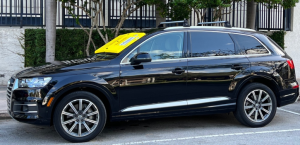By Jeff Sanford
Toronto, Ontario — November 2, 2017 — In this week’s edition of Friday Fun, we look into a flurry of odd accidents, new concerns about distracted driving, cobalt supplies may limit the growth of the electric vehicle market and much, much more!
-It seemed there were more than the average number of bizarre car accidents this week:
In the Ontario city of Brampton a Corvette landed on top of a small car parked in a driveway. Firefighters had to extricate the trapped driver. Pictures from the scene show the Corvette sitting perpendicular on top of a Toyota Yaris. It’s not clear how the car ended up on top of the other, according to a media report. .
Also in Brampton this past week, a Twitter user posted a video that shows a motorist driving rapidly in reverse on a busy street. A local report notes that, “In the video, you can see a silver Pontiac slowly ease through a green light southbound near Dixie Road past Steeles Avenue. At about 15 seconds into the video, you can see the car pick up speed as it continues heading south, keeping up with the flow of traffic. While it’s unclear why the driver felt the need to put both himself and others at risk …” The story goes on to suggest that, “… most likely had a broken transmission and didn’t want to pay for a tow.”
This past week the Woodstock-Sentinel Review ran a story about a 21-year-old Windsor resident now facing charges after police boxed in a stolen vehicle. According to the story, “Woodstock police said they received information around 9 p.m. Thursday evening that a Black Dodge Caliber westbound on Highway 2 was driving all over the road with its four-way flashers activated … Officers located the vehicle and followed it, observing the driver disobey several red lights … Even after police activated the cruiser’s emergency lights and sirens the driver refused to stop.” According to the story the pursuit was called off due to public safety concerns. But “… officers noticed that the vehicle slowed down and because the four-way flashers were activated it was easy to follow the vehicle at a discrete distance.” The vehicle was eventually boxed in and the driver arrested.
In Cleveland last week a 10-year-old boy led police on a high-speed pursuit that ended miles away on the Ohio Turnpike. According to police, this is the second time in two weeks the boy has taken cars on joyrides. According to the story, “Authorities say no one was injured during the pursuit that began around 9:30 a.m. Thursday when Westlake police saw a car speed by chased by another vehicle, possibly driven by the boy’s mother … A man called 911 and reported the boy’s car was swerving in and out of traffic and had almost run several vehicles off the road. He also said a woman was following him in a red SUV. A woman called 911 and said the boy appeared to be driving around 144 km/h.” Three officers tried to stop the car and ended up following it for more than 24 kilometres at high speed. Eventually the boy drove through a toll booth and onto the westbound lanes of the Ohio Turnpike. One of the troopers used his cruiser to nudge the boy’s car into a sign while other police cars blocked it in.
-Another angle on the “distracted driving” debate emerged last week. A Liberal MPP in Toronto is introducing a private members bill titled, “Phones Down, Heads Up Act.” According to a summary of the bill obtained by the Toronto Star the new law would “ban pedestrians from crossing the road while holding and using a wireless communication device, electronic entertainment device, or other prescribed device.”
People contravening the bill could be served a $50 fine on the first offence, $75 on a second and $125 on a third. The ban wouldn’t apply if someone was using a phone to contact emergency services, or “to continue a phone call that was started before crossing the roadway.” According to the story in the Star a “prominent pedestrian safety advocate slammed the proposed ‘distracted walking’ legislation.” The pedestrian activists pointed that a 2015 Toronto Public Health report on road safety determined pedestrian inattentiveness was a factor in just 13 percent of serious collisions. The same report indicates that cellphone use by drivers is, “… a major and growing cause of serious collisions.”
According to the Star, “The OPP now says distracted driving is the leading cause of traffic deaths on the province’s highways last year, and now exceeds alcohol- or speed-related fatalities.” That is, it would be more useful to crack down on distracted drivers rather than ticketing people crossing the street. John Tory, mayor of Toronto, seemed to agree. He was quoted as saying, “You know, the idea that we’re going to have more people out writing up tickets and handing them to people who are crossing the street without the care they might [take] just doesn’t strike me necessarily as the best use of resources.”
-Volvo released details about the company’s new electric vehicle brand, Polestar, which arrives in the 2019 model year. According to a report on Ars Technica, the body will feature an extensive use of carbon fibre. One report notes that the new car will be developed according to Volvo’s Scalable Product Architecture, which provides, “… the building blocks for a number of vehicles.” The story goes on to discuss how it is Volvo is fitting into the emerging Chinese auto conglomerate, Geely. “The past few years have been good ones for Volvo. Parent company Geely has been a generous, hands-off benefactor, and the results are showing. The Swedish automaker is now one of the most forward-thinking in the industry and a home to good engineering and design across disciplines that include interiors, infotainment, and autonomous driving,” according to the report. The new Polestar is a perfect example.
-A Tesla owner in Toronto is annoyed the city won’t give him a permit to build a charging station outside his home. Many people in the city use on-street parking. The problem is what to do about charging a car overnight. The homeowner hoped to run power from his home to the vehicle by digging a channel underneath the sidewalk. But according to the Tesla owner contractors who specialize in installing the chargers told him they couldn’t work on city property. Running charging cords across sidewalks is a safety risk, according to the city. This has left the EV owners fuming, and out of energy. Wall Street financial services giant Morgan Stanley released a report recently that estimates the world would have to spend massive $2.7 trillion USD to create the charging stations necessary to support 500 million electric vehicles.
-If electric vehicles are the future the economy will be dependent than ever upon mines in the Democratic Republic of Congo, where, according to a report by the Malay Mail, “… there has never been a peaceful transition of power and child labour is still used in parts of the mining industry.” The story notes that demand is surging for lithium-ion batteries that are used in EVs. This is driving demand for the materials needed to make the batteries. One necessary ingredient is cobalt, 63 percent of which comes from the Congo. Few markets are so dominated by one supplier.
According to the story, the market share the country enjoys may jump to 73 percent by 2025 as producers expand mines in the country to meet new demand. This will enrich the current authoritarian ruler of the country, President Joseph Kabila, who came to power after his father seized control of the country from Mobutu Sese Seko in 1997. When the father was assassinated, Kabila took over. His family now has a, “… vast business network that reaches every corner of the economy, including mining interests,“ according to the report. Needless to say the country remains politically volatile.
“There are lot of grand plans being put in place by automotive manufacturers, but not many of them seem to have considered the cobalt-supply chain,” said an analyst from Wood Mackenzie quoted in the story. A typical power unit in an electric car contains about 15 kilograms of cobalt. Prices for the commodity have more than doubled in the past year to $60,125 a metric ton.





































